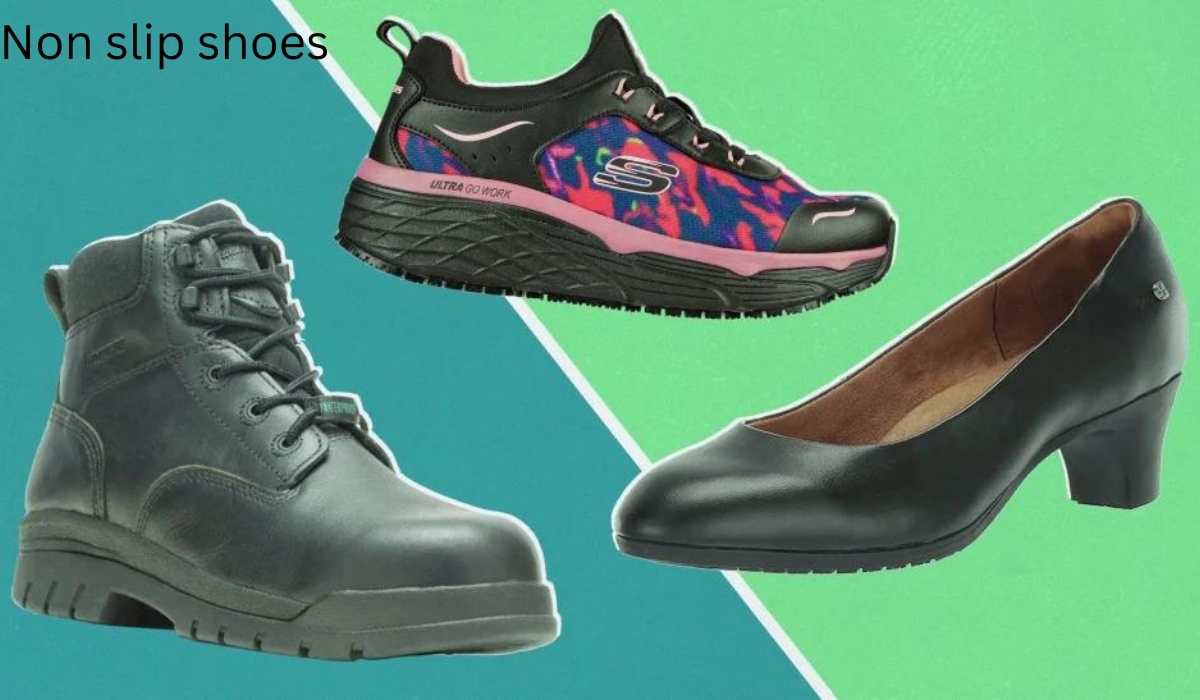Fashion
The Ultimate Guide to Non-Slip Shoes: Keeping You Safe and Stylish

Introduction:
Non-slip shoes are not just another footwear option; they’re a game-changer in ensuring safety and comfort, especially in environments where slippery surfaces pose a risk. Whether you’re working in a restaurant, hospital, or simply navigating through rainy streets, non-slip shoes provide the traction you need to stay on your feet. In this comprehensive guide, we’ll delve into everything you need to know about non-slip shoes, from their benefits to how to choose the perfect pair for your needs.
Benefits of Non-Slip Shoes:
- Enhanced Safety: The primary benefit of non-slip shoes is their ability to provide traction on slippery surfaces, significantly reducing the risk of slips, trips, and falls. This is especially crucial in workplaces where spills or wet floors are common, such as kitchens, hospitals, and industrial settings.
- Comfort: Non-slip shoes are designed with features that prioritize comfort, such as cushioned insoles, supportive arches, and breathable materials. This ensures that you can stay on your feet for extended periods without discomfort or fatigue.
- Durability: Many non-slip shoes are constructed with durable materials that can withstand the demands of various work environments. Whether you’re constantly on the move or standing for long hours, these shoes are built to last.
- Versatility: While non-slip shoes are essential for certain professions, they’re also suitable for everyday wear. Whether you’re running errands or enjoying outdoor activities, non-slip shoes provide reliable traction on a variety of surfaces.
Types of Non-Slip Shoes:
- Work Shoes: Designed specifically for professionals in industries such as healthcare, food service, and construction, work shoes feature slip-resistant outsoles and often include additional safety features such as toe protection and waterproofing.
- Athletic Shoes: Many athletic shoe brands offer non slip options designed for sports and outdoor activities. These shoes prioritize traction without compromising on performance, making them ideal for runners, hikers, and athletes.
- Casual Shoes: Non slip technology is increasingly being incorporated into casual footwear styles, including sneakers, boots, and loafers. These shoes offer the versatility to transition seamlessly from work to leisure activities.
Features to Look For:
- Slip-Resistant Outsoles: The most important feature of non slip shoes is their outsoles, which are typically made from rubber or synthetic materials with tread patterns designed to provide maximum traction on slippery surfaces.
- Comfortable Insoles: Look for shoes with cushioned insoles that offer support and shock absorption, reducing fatigue and discomfort, especially during long periods of wear.
- Waterproof Materials: For environments where exposure to liquids is common, such as kitchens or outdoor work sites, opt for shoes made from waterproof materials to keep your feet dry and comfortable.
- Supportive Construction: Choose shoes with features such as arch support and ankle stability to reduce the risk of strain and injury, particularly if you’re on your feet for extended periods.
How to Choose the Right Non-Slip Shoes:
- Consider Your Environment: Assess the specific hazards of your work or daily activities to determine the level of slip resistance and additional features you need in your shoes.
- Try Them On: Fit is crucial when it comes to non slip shoes, so try on multiple pairs and walk around to ensure they’re comfortable and provide adequate support.
- Read Reviews: Research different brands and styles online to see what other customers have to say about their experiences with non-slip shoes, paying attention to factors such as durability and effectiveness.
- Look for Certifications: Some non-slip shoes may carry certifications from organizations such as ASTM International or the Occupational Safety and Health Administration (OSHA), indicating that they meet certain safety standards.
Care and Maintenance:
- Regular Cleaning: Keep your non-slip shoes clean by wiping them down with a damp cloth after each use, especially if they come into contact with oils, grease, or other substances that could compromise their traction.
- Inspect for Wear: Periodically check your shoes for signs of wear and tear, such as worn-out treads or damaged materials, and replace them as needed to maintain their effectiveness.
- Follow Manufacturer’s Guidelines: Refer to the manufacturer’s instructions for specific care and maintenance recommendations for your non-slip shoes, including how to clean them and when to replace them.
- YOU MAY ALSO like. Nike Tech Fleece Explained: Unveiling the Comfort Revolution
Conclusion:
Non-slip shoes are a practical and essential footwear choice for anyone seeking to prioritize safety and comfort in environments where slippery surfaces are a concern. With a wide range of styles and features available, finding the perfect pair to suit your needs has never been easier. By understanding the benefits, features, and selection criteria outlined in this guide, you can make an informed decision and step confidently into any situation, knowing that you’re equipped with the traction and support you need to stay safe and stylish.
FAQ;S.
1. Are non-slip shoes only for work environments?
- No, non-slip shoes are not limited to work environments. While they are commonly used in professions where slips and falls are a risk, such as healthcare and food service, they are also suitable for everyday wear and outdoor activities. Many brands offer non-slip options in various styles, including athletic shoes and casual footwear.
2. How do I know if a pair of shoes is non-slip?
- Non-slip shoes are typically identified by their slip-resistant outsoles, which feature tread patterns designed to provide traction on slippery surfaces. Look for shoes that are specifically labeled as “non-slip” or “slip-resistant.” Additionally, you can check for certifications from organizations such as ASTM International or OSHA, which indicate that the shoes meet certain safety standards.
3. Can non-slip shoes be comfortable for long-term wear?
- Yes, many non-slip shoes are designed with features that prioritize comfort, such as cushioned insoles, supportive arches, and breathable materials. These features help reduce fatigue and discomfort, making non-slip shoes suitable for long-term wear, even in demanding environments.
4. How should I care for my non-slip shoes to maintain their effectiveness?
- To maintain the effectiveness of your non-slip shoes, it’s important to keep them clean and inspect them regularly for signs of wear and tear. Clean your shoes with a damp cloth after each use, especially if they come into contact with oils or grease. Additionally, check the treads and materials for any damage, and follow the manufacturer’s guidelines for care and maintenance.
5. Are non-slip shoes waterproof?
- Some non-slip shoes are made from waterproof materials, which can be beneficial
Fashion
Exploring the Intechzoom Rolex Submariner: A Comprehensive Guide

Introduction:
The Rolex Submariner stands as an iconic timepiece, renowned for its durability, precision, and timeless design. Among the vast array of luxury watches, the Intechzoom Rolex Submariner holds a unique position, offering enthusiasts a blend of traditional craftsmanship and cutting-edge technology. In this comprehensive guide, we delve into every aspect of the Intechzoom Rolex Submariner, examining its history, design, features, performance, and the allure it holds for watch aficionados worldwide.
- A Brief History of Rolex Submariner:
- Origins and Development: The inception of the Rolex Submariner in the 1950s marked a significant milestone in the world of horology. Initially conceived as a diver’s tool watch, it quickly gained popularity among professional divers and enthusiasts alike.
- Evolution of Design:
- Over the decades, the Submariner has undergone several iterations, with each model incorporating advancements in technology and design aesthetics. From its early references to the modern-day iterations, the Submariner has maintained its signature elements while adapting to the changing preferences of consumers.
- Introducing Intechzoom:
- The Collaboration: Intechzoom, known for its innovative approach to watchmaking, joined forces with Rolex to create a special edition of the Submariner. This collaboration brought together the craftsmanship of Rolex with the technological expertise of Intechzoom, resulting in a watch that embodies the best of both worlds.
- Unique Features:
- The Intechzoom Rolex Submariner distinguishes itself with a range of unique features, from its materials and construction to its performance capabilities and aesthetic enhancements. These features set it apart from the standard Submariner models and elevate it to a coveted status among collectors.
- Design and Aesthetics:
- Case and Bracelet: The Intechzoom Submariner boasts a robust case crafted from high-grade stainless steel, ensuring durability and resistance to corrosion. The bracelet, meticulously designed for comfort and style, complements the overall aesthetics of the watch.
- Dial and Bezel: The dial of the Intechzoom Submariner is a masterpiece of precision engineering, featuring luminescent markers and hands for enhanced visibility in low-light conditions. The unidirectional rotatable bezel, adorned with a ceramic insert, adds a touch of elegance and functionality to the timepiece.
- Performance and Functionality:
- Water Resistance: True to its origins as a diver’s watch, the Intechzoom Submariner offers exceptional water resistance, allowing it to withstand depths of up to 300 meters (1000 feet). This level of performance ensures reliability in the most demanding underwater environments.
- Movement and Accuracy: At the heart of the Intechzoom Submariner beats a high-precision mechanical movement, engineered to deliver unparalleled accuracy and reliability. With its self-winding mechanism and COSC certification, this watch exemplifies the pinnacle of horological craftsmanship.
- Collectibility and Value:
- Limited Edition Appeal: As a collaboration between Rolex and Intechzoom, the Intechzoom Submariner is produced in limited quantities, adding to its exclusivity and collectibility. Watch enthusiasts and collectors eagerly seek out these special edition pieces, recognizing them as valuable additions to their collections.
- Investment Potential:
- Over the years, Rolex watches have proven to be sound investments, appreciating in value over time. The Intechzoom Submariner, with its unique design and limited availability, is particularly sought after by investors looking to diversify their portfolios with tangible assets.
- The Intechzoom Experience:
- Ownership and Wearing Experience: Owning an Intechzoom Rolex Submariner is more than just possessing a timepiece; it’s an experience that transcends mere functionality. The craftsmanship, heritage, and prestige associated with the brand elevate the ownership experience to new heights.
- Community and Camaraderie: The Intechzoom Submariner fosters a sense of community among its owners, who share a passion for horology and a deep appreciation for fine craftsmanship. Whether attending exclusive events or engaging in online forums, Intechzoom Submariner owners form bonds that extend beyond the realm of watches.
- Conclusion:
- The Intechzoom Rolex Submariner represents the epitome of luxury watchmaking, blending heritage with innovation to create a timepiece that captivates the senses and inspires admiration. From its impeccable design to its exceptional performance, every aspect of the Intechzoom Submariner speaks to the discerning tastes of watch connoisseurs worldwide. Whether as a treasured heirloom or a wise investment, the Intechzoom Submariner continues to hold its place as a symbol of timeless elegance and enduring craftsmanship.
In conclusion, the Intechzoom Rolex Submariner stands as a testament to the enduring legacy of Rolex and the innovative spirit of Intechzoom. With its distinctive design, exceptional performance, and timeless appeal, it remains a coveted prize for collectors and enthusiasts alike, embodying the pinnacle of horological .
YOU MAY ALSO LIKE;Nike Tech Fleece Explained: Unveiling the Comfort Revolution
FAQs (Frequently Asked Questions)
- Is the Intechzoom Rolex Submariner suitable for everyday wear?
- Yes, the Intechzoom Submariner’s robust construction and versatile design make it ideal for daily wear, whether in professional or casual settings.
- Does the Intechzoom Submariner come with a warranty?
- Yes, like all Rolex watches, the Intechzoom Submariner is covered by an international warranty, providing peace of mind to its owners.
- Can I swim with the Intechzoom Rolex Submariner?
- Absolutely, the Intechzoom Submariner is water-resistant up to 300 meters (1000 feet), making it suitable for swimming, snorkeling, and diving.
- How can I authenticate my Intechzoom Submariner?
- To ensure authenticity, it’s recommended to purchase from authorized dealers or request a Certificate of Authenticity from Intechzoom or Rolex.
- What makes the Intechzoom Submariner different from standard Rolex models?
- The Intechzoom Submariner features unique design elements and technological innovations, setting it apart as a special edition collaboration between Intechzoom and Rolex.
Blog
The Ultimate Guide to Tea Tree Oil Shampoo: Benefits, Uses, and Tips

Introduction:
Tea tree oil shampoo has gained immense popularity in recent years for its numerous benefits for hair and scalp health. Derived from the leaves of the Melaleuca alternifolia plant native to Australia, tea tree oil possesses powerful antimicrobial, anti-inflammatory, and antifungal properties that make it a versatile ingredient in hair care products. In this comprehensive guide, we’ll explore everything you need to know about shampoo, including its benefits, uses, and tips for incorporating it into your hair care routine.
Chapter 1: Understanding Tea Tree Oil
- What is Tea Tree Oil?
- Origins and History of Tea Tree Oil Shampoo
- Composition and Properties of Tea Tree Oil Shampoo
- How is Tea Tree Oil Extracted?
Chapter 2: The Science Behind Tea Tree Oil
- How Does Tea Tree Oil Shampoo Benefit Hair and Scalp Health?
- Antimicrobial Properties: Fighting Dandruff and Scalp Infections
- Anti-inflammatory Effects: Soothing Irritated Scalp
- Antifungal Properties: Combatting Fungal Infections like Ringworm
- pH Balance: Maintaining Healthy Scalp Environment
Chapter 3: Benefits of Using Tea Tree Oil Shampoo
- Promotes Healthy Hair Growth: Stimulating Hair Follicles
- Helps Control Dandruff and Flakes: Treating Seborrheic Dermatitis
- Soothes Itchy Scalp: Relieving Irritation and Inflammation
- Cleanses Scalp and Hair: Removing Buildup and Excess Oil
- Adds Shine and Moisture: Hydrating Dry Hair
- Suitable for All Hair Types: Gentle Yet Effective
Chapter 4: How to Use Tea Tree Oil Shampoo
- Choosing the Right Shampoo: Factors to Consider
- Proper Application Techniques: Step-by-Step Guide
- Frequency of Use: Finding the Balance
- Precautions and Considerations: Potential Side Effects and Allergies
Chapter 5: Tips for Maximizing the Benefits
- Use Tea’ Tree Oil Shampoo as Part of a Holistic Hair Care Routine
- Combine with Other Natural Ingredients for Enhanced Effects
- Avoid Overuse: Moderation is Key
- Patch Test: Checking for Allergic Reactions
- Consult a Dermatologist or Trichologist for Persistent Scalp Issues
Chapter 6: DIY Tea Tree Oil Shampoo Recipes
- Basic Tea Tree Oil Shampoo Recipe
- This Shampoo for Dandruff
- Tea Tree Oil Shampoo for Oily Scalp
- Tea Tree Oil Shampoo for Dry Scalp
Chapter 7: Frequently Asked Questions (FAQs)
- Can Tea ,Tree Oil Shampoo be Used on Color-Treated Hair?
- Is Tea Tree Oil Shampoo Safe for Children?
- Can Tea, Tree Oil Shampoo Help with Hair Loss?
- How Long Does it Take to See Results?
- Are There Any Contraindications for Using Tea Tree Oil Shampoo?
- YOU MAY ALSO LIKE. Acknowledging the Necessity of Estate Planning in Light of Modern Family Dynamics
Conclusion:
Tea tree shampoo offers a natural and effective solution for promoting healthy hair and scalp. With its potent antimicrobial, anti-inflammatory, and antifungal properties, it addresses a wide range of hair and scalp concerns, from dandruff to itchiness and beyond. By incorporating tea tree oil shampoo into your hair care routine and following the tips outlined in this guide, you can enjoy stronger, shinier, and healthier hair, naturally. So why wait? Start reaping the benefits of tea tree oil shampoo today!
FAQS.
- Can Tea Tree Oil Shampoo be Used on Color-Treated Hair?
- Answer: Yes, in most cases, shampoo is safe to use on color-treated hair. However, it’s essential to check the product label for any specific instructions or warnings regarding color-treated hair. Some formulations may be gentler and more suitable for maintaining the vibrancy of colored hair.
- Is Tea Tree Oil Shampoo Safe for Children?
- Answer: While tea tree oil is generally considered safe for adults when used in proper dilution, it’s advisable to consult with a pediatrician before using shampoo on children. Children’s scalps can be more sensitive, so it’s crucial to ensure that the product is safe and suitable for their age and skin type.
- Can Tea Tree Oil Shampoo Help with Hair Loss?
- Answer: Tea tree shampoo is primarily known for its ability to promote scalp health and alleviate conditions like dandruff and itching, which can indirectly support healthy hair growth. However, there is limited scientific evidence to suggest that tea tree oil directly aids in hair regrowth or prevents hair loss. It’s best to manage hair loss concerns with a comprehensive approach, including consulting with a healthcare professional if needed.
- How Long Does it Take to See Results from Using Tea Tree Oil Shampoo?
- Answer: The time it takes to see results from using shampoo can vary depending on individual factors such as hair type, scalp condition, and frequency of use. Some people may experience immediate relief from scalp itching or dandruff, while others may need several weeks of consistent use to notice significant improvements. It’s essential to be patient and consistent with your tea tree oil shampoo regimen to maximize its benefits.
- Are There Any Contraindications for Using Tea Tree Oil Shampoo?
- Answer: While tree oil shampoo is generally safe for most people when used as directed, there are some considerations to keep in mind. Individuals with sensitive skin or allergies may experience irritation or allergic reactions to tea tree oil. It’s also essential to avoid getting the shampoo in your eyes, as it can cause irritation. If you experience any adverse reactions or discomfort, discontinue use immediately and consult with a healthcare professional
Fashion
“The Enigmatic Moatee: Unraveling the Mysteries of the Sea Cow”

“The Enigmatic Moatee: Unraveling the Mysteries of the Sea Cow”
Introduction:
Welcome to the enchanting world of the moatee! If you’re curious about these fascinating creatures, you’ve come to the right place. In this comprehensive guide, we’ll delve deep into the world of moatees, exploring their habitat, behavior, diet, conservation status, and much more. So, sit back, relax, and let’s embark on a journey to discover the wonders of the majestic moatee.
What is a Moatee?
A moatee, also known as a “motee,” is a remarkable marine mammal that belongs to the order Sirenia. These gentle giants are commonly found in tropical and subtropical waters around the world. Moatees are often referred to as “sea cows” due to their large, herbivorous nature and slow, ponderous movements underwater.
Appearance:
- Moatees possess a unique appearance characterized by their large, cylindrical bodies and paddle-like flippers.
- They typically range in color from gray to brown, with a thick, wrinkled skin that provides protection against the elements.
- One of the most distinctive features of moatees is their rounded snout, which they use to grasp vegetation while feeding.
Habitat:
- Moatees are primarily found in shallow, coastal waters, including rivers, estuaries, and lagoons.
- They prefer habitats with abundant vegetation, as they are herbivores and rely on aquatic plants for sustenance.
- While moatees are primarily aquatic, they can also venture into brackish and freshwater environments.
Behavior:
- Moatees are known for their calm and gentle demeanor, spending much of their time grazing on aquatic plants.
- They are primarily solitary animals but may form small groups, especially during mating season or when foraging in areas with abundant food.
- Despite their large size, moatees are surprisingly agile swimmers, capable of maneuvering gracefully through the water with their powerful tails.
Diet:
- As herbivores, moatees have a specialized diet consisting mainly of aquatic vegetation such as seagrasses, algae, and water hyacinths.
- They use their prehensile lips to pluck vegetation from the water or scrape it from submerged surfaces.
- Moatees have a slow metabolism, requiring them to consume large quantities of vegetation to meet their nutritional needs.
Reproduction:
- Female moatees reach sexual maturity between the ages of 3 and 5, while males mature slightly later.
- Mating typically occurs year-round, although peak breeding seasons may vary depending on the region.
- After a gestation period of approximately 12 months, females give birth to a single calf, which they nurse for up to two years.
Conservation Status:
- Despite their peaceful nature, moatees face numerous threats to their survival, including habitat loss, pollution, boat collisions, and hunting.
- The three species of moatees—the West Indian, Amazonian, and West African—are all listed as either vulnerable or endangered by the International Union for Conservation of Nature (IUCN).
- Conservation efforts aimed at protecting moatees include habitat preservation, regulation of boat traffic in sensitive areas, and public awareness campaigns to reduce human impacts on these vulnerable animals.
- YOU MAY ALSO LIKE. Unraveling the Potential of WAVR-297: A Breakthrough in Technology
Conclusion:
The moatee is truly a remarkable creature, deserving of our admiration and protection. By learning more about these gentle giants and supporting conservation efforts, we can ensure that future generations will continue to marvel at the beauty and majesty of the moatee. So, let’s join together in safeguarding the future of these extraordinary animals and the fragile ecosystems they call home.
FAQS.
1. What do moatees eat?
- Moatees are herbivores and primarily consume aquatic vegetation such as seagrasses, algae, and water hyacinths. They use their prehensile lips to grasp and eat the vegetation.
2. Where do moatees live?
- Moatees are commonly found in tropical and subtropical waters around the world, including rivers, estuaries, lagoons, and coastal areas. They prefer habitats with abundant vegetation for grazing.
3. Are moatees endangered?
- Yes, moatees are considered vulnerable or endangered species by the International Union for Conservation of Nature (IUCN). Threats such as habitat loss, pollution, boat collisions, and hunting have contributed to their declining populations.
4. How big do moatees get?
- Moatees can vary in size depending on the species, but they typically range from 8 to 14 feet in length and weigh between 800 to 1,300 pounds. Some individuals may grow larger, with the West Indian species being the largest of the three moatee species.
5. What is the difference between moatees and manatees?
- Moatees and manatees are both members of the order Sirenia and share many similarities. However, there are some differences between them, including geographical distribution, size, and subtle anatomical variations. Manatees are typically found in the Americas, while moatees have a more widespread distribution. Additionally, moatees tend to have a more rounded snout compared to the more pointed snout of manatees.
-

 Technology5 months ago
Technology5 months agoEnhancing Cybersecurity: Understanding SIEM and Its Impact on Threat Management
-

 Travel7 months ago
Travel7 months agoThe Back Bay Station: Exploring the Heart of Boston
-

 News5 months ago
News5 months agoMcDonald’s New Adult Happy Meal: A Unique Twist for All Ages
-

 Travel5 months ago
Travel5 months agoRefining Your Travel Adventures within Budget: Intelligent Tactics for Astute Explorers
-

 Technology5 months ago
Technology5 months agoUnveiling Geöe: The Leading Edge in Sustainable Solutions for 2024 and Beyond
-

 Blog4 months ago
Blog4 months agoThe Spartan Integrity: An In-Depth Look at Spartan Capital Securities LLC broker jordan meadow and Its Path Forward
-

 Business3 months ago
Business3 months agoAdapting to Change: How Flexible Office Spaces Fuel Productivity and Growth
-

 Travel7 months ago
Travel7 months agoExecutive Large Office Moving Services Sherman Oaks






















